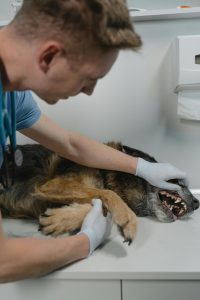In This Article
ToggleA car accident is one of the scariest things that can happen to a dog. Whether a dog is hit by a moving car or involved in a crash while inside a vehicle, the biggest concern for any pet owner is: Chances of a Dog Surviving a Car Accident. The truth is, some dogs manage to escape with minor injuries, while others suffer life-threatening trauma. Their chances of survival depend on several factors, including the speed of the car, the point of impact, their size and health, and how quickly they receive medical attention. Many dogs die in car accidents every year.
When a dog is hit by a car, their body absorbs the impact, causing broken bones, internal bleeding, or head trauma. Some go into shock or run away due to fear and adrenaline. If inside a car, survival depends on being restrained and the crash’s severity. Immediate veterinary care is crucial, as minor injuries can become life-threatening without treatment. Internal bleeding, fractures, or organ damage may not show symptoms but can be fatal. This article covers survival chances, crash impacts, hidden injuries, recovery steps, why dogs run after accidents, and how to prevent tragedies. Being informed can protect your furry friend’s life.
What Are the Odds of a Dog Surviving a Car Accident?
Understanding the Odds: Can Dogs Survive Car Accidents?

A dog getting hit by a car is every pet owner’s nightmare. The first thought is always, “Will my dog survive?” The response is dependent on a number of important variables, such as the vehicle’s speed, the dog’s size and breed, the hit site, and how rapidly doctor’s help is received. Some dogs escape with minor injuries, while others suffer life-threatening trauma. Understanding these survival odds can help owners react quickly and take the right steps to improve their dog’s chances of making it through.
What Are the Odds of a Dog Surviving a Car Accident?
The chances of survival vary depending on the severity of the accident. Studies show that dogs who receive immediate veterinary care after being hit by a car have a survival rate of over 80%. However, the outcome depends on several factors.
Speed of the Car
If a car is moving slowly, under 20 mph, a dog may only suffer minor injuries like bruises or small cuts. At speeds between 30-40 mph, injuries become more serious, often including broken bones, internal bleeding, or shock. If a dog is hit at 50 mph or higher, the chances of survival drop significantly, and injuries are often fatal.
Dog’s Size and Breed
Larger dogs, like Golden Retrievers, Huskies, or German Shepherds, have a better chance of survival because their bodies can absorb more impact. Their bones are stronger, and they have more muscle mass to protect vital organs. Smaller breeds, like Chihuahuas, Toy Poodles, or Yorkshire Terriers, are at higher risk because their bones are fragile, and even a minor impact can cause life-threatening injuries.
Where the Dog Was Hit
If a car hits a dog’s legs or side, the chances of survival are much higher, though they may suffer broken bones or internal injuries. If a dog is hit in the head or chest, the risk of death increases because of brain trauma or lung damage.
The Dog’s Health Before the Accident
Young, healthy dogs tend to recover faster from accidents because their bodies are strong and can heal better. Older dogs or those with existing health issues, such as heart disease or arthritis, have a harder time surviving and recovering from serious injuries.
Immediate Medical Care
The faster a dog gets medical attention, the higher their chances of survival. Even if a dog seems fine, internal injuries can take hours or days to show symptoms. Emergency vet care is crucial in preventing fatal complications.
How Often Do Dogs Survive Car Accidents?
There are no exact statistics worldwide, but veterinarians report that most dogs who receive medical care within the first hour of an accident have a strong chance of survival. Dogs hit by slow-moving cars below 20 mph have an estimated survival rate of 85-90% with treatment. Dogs hit at moderate speeds between 30-40 mph have around a 50-70% survival rate, depending on the injuries. Dogs hit at high speeds of 50 mph or more have a low survival rate, often under 20-30%, as injuries tend to be severe.
Dogs inside cars during accidents have a higher survival rate if they are properly restrained, but serious crashes can still cause fatal injuries. While many dogs do survive car accidents, some may suffer long-term health issues like nerve damage, chronic pain, or difficulty walking. Rehabilitation, surgeries, and physical therapy may be needed to help them recover.
What Takes Place When a Dog Gets into a Car Accident?

When a dog is hit by a car or involved in a car crash, it can lead to traumatic injuries. The impact depends heavily on factors like the speed of the vehicle, the location where the dog is hit, and whether they are inside the vehicle or on the road. Understanding these circumstances can help pet owners react quickly and potentially save their dog’s life.
If a dog is hit by a car while crossing the street, their body absorbs the impact. High-speed collisions can cause severe injuries like broken bones, internal bleeding, or head trauma. Most dogs are not thrown far from the impact, but may still suffer internal damage to organs like the lungs, liver, or kidneys, which may not be immediately visible. The severity depends on the car’s speed and where the dog is hit.
For dogs inside a car during a crash, the situation is different. If a dog is unrestrained, they are at a higher risk of injury. During sudden braking, swerving, or a crash, dogs can be thrown around inside the car, hitting windows or other parts. Properly restrained dogs with seat belts or crates are less likely to sustain severe injuries, as restraints absorb some of the force and keep them in place. Unrestrained dogs may hit their heads, leading to injuries. In a severe impact or flip, unrestrained dogs are at risk of severe injury or death.
Even though dogs are generally smaller and more agile than other animals, the impact of a car collision can be fatal for them.The severity of injury in most accidents depends on where the car strikes the dog, the car’s speed, and how quickly medical attention is provided.
Do Animals Survive Car Accidents?
Not all animals are as lucky as dogs when it comes to surviving a car crash. Survival rates vary greatly between different species. While dogs have a relatively high chance of surviving if they get immediate care, other animals like deer, raccoons, or squirrels are often killed instantly in car accidents because they are larger and harder to avoid. They may be hit at higher speeds or have more significant impacts because of their size, resulting in fatal injuries.
For dogs, the survival rate can be as high as 80% if treated quickly, especially in low-speed accidents. Larger animals often have fewer survival opportunities because of their vulnerability to high-speed impacts. However, wildlife accidents tend to result in more severe outcomes because these animals often do not get medical help in time, especially if they are hit while crossing busy highways or rural roads.
Common Injuries in Pet Accidents
Dogs involved in car accidents can suffer from a range of injuries, which vary in severity depending on the nature of the collision. Some of the most common injuries in pet accidents include:
- Broken Bones
Broken bones are one of the most common injuries in a car crash. When a dog is hit, their legs, ribs, or other bones can fracture. For example, broken limbs may require immediate care and can take weeks to heal, often needing surgery to properly set the bone. - Internal Bleeding
One of the more serious injuries is internal bleeding, which is not always visible. This type of injury occurs when a dog’s internal organs—such as the lungs, liver, or spleen—are damaged by the force of the crash. Even if the dog looks okay externally, internal bleeding can be life-threatening if left untreated. - Head Trauma
Head injuries are particularly dangerous and can occur if a dog is thrown against a hard surface or has their head hit during a crash. Concussions, skull fractures, and brain injuries can lead to long-term neurological damage. Symptoms of head trauma in dogs include disorientation, balance issues, or unconsciousness. - Shock and Organ Damage
Shock is a common response when a dog experiences severe trauma. This occurs when the blood flow to vital organs is reduced, causing the dog’s heart rate to increase and blood pressure to drop. Shock is a medical emergency, as it can cause organ failure if not treated quickly. Internal organ damage to vital organs like the heart, lungs, or kidneys can occur in a car crash, sometimes without visible signs.
Do Dogs Go into Shock When Hit by a Car?
Yes, shock is a very real and dangerous response for dogs hit by a car. Shock occurs when a dog’s body goes into survival mode, reducing blood flow to the extremities and focusing on keeping vital organs functioning. This results in a rapid heartbeat, shallow breathing, and cold skin. Dogs in shock may seem weak, disoriented, and lethargic.
Some common signs of shock in dogs after an accident include:
- Pale or blue gums
- Rapid breathing , shallow breathing
- Weak pulse or irregular heartbeat
- Cold, damp skin (especially on the paws or ears)
- Confusion or lack of coordination
- Lethargy or unconsciousness
If your dog is showing signs of shock after an accident, getting immediate veterinary help is essential. Shock is life-threatening if not treated in time. Treatment usually involves fluids, medications to stabilize the blood pressure, and close monitoring at a veterinary clinic.
In conclusion, when a dog is hit by a car, the injuries can range from minor to severe, and in some cases, even fatal. Speed, the location of the impact, and the dog’s size and health all play a major role in determining the outcome. Whether a dog survives or not can depend on how quickly they receive care after the accident. Understanding common injuries like broken bones, internal bleeding, and shock will help pet owners recognize symptoms and get their dog the care they need right away. If your dog does survive a car accident, they may face a long recovery process, but with the right treatment and care, many dogs go on to heal fully.
How to Know If Your Dog is Okay After a Car Accident

If your dog has been involved in a car accident, it’s crucial to evaluate their condition right away. Even if your dog seems to be walking around or acting normal after the impact, they might still have serious injuries that are not visible at first. Some injuries can be hidden inside the body, such as internal bleeding or organ damage. Dogs are also good at hiding pain, which is why you shouldn’t rely solely on how they’re acting.
Signs of Internal Injuries That May Not Be Visible
Internal injuries in dogs after a car accident can be life-threatening but hard to spot with the naked eye. One of the most dangerous things is internal bleeding, which might not show until it’s too late. The dog’s body will try to compensate for the blood loss, so it’s essential to look for these signs:
- Pale or blue gums: Gums that are unusually pale or have a bluish tint can indicate poor circulation or oxygen deprivation. This could point to internal bleeding or shock.
- Rapid breathing or trouble breathing: If your dog is panting excessively, having shallow breaths, or struggling to breathe, it could mean they have lung damage, broken ribs, or other injuries.
- Vomiting or coughing up blood: Any signs of vomiting blood or coughing it up might suggest damage to the lungs, stomach, or esophagus. This requires immediate veterinary attention.
- Lethargy or weakness: If your dog seems unusually tired, weak, or unable to stand up, it could be a sign of internal organ damage or shock. It may result in organ failure if treatment is not received.
- Swelling in the abdomen: A swollen stomach or belly is a serious sign that your dog might have internal bleeding or other significant internal injuries. It can be caused by ruptured organs or blood buildup in the abdomen.
When to Seek Emergency Veterinary Care

Even if your dog seems okay, emergency veterinary care is crucial right after a car accident. Dogs might show no obvious external injuries, but they could still be in critical condition. If your dog displays any of the following symptoms, you must get them to a veterinarian immediately:
- Loss of consciousness: If your dog is knocked out or seems disoriented, it’s a sign that they may have a concussion, head trauma, or other serious neurological injuries.
- Pale, blue, or purple gums: If your dog’s gums are pale or blue, it’s an urgent sign that they’re not getting enough oxygen and need immediate care.
- Uncontrolled bleeding: Severe bleeding from any part of the body requires urgent attention. Internal bleeding might also present as vomiting or coughing blood, so don’t wait for visible signs to stop.
- Limping or not moving: If your dog is unable to move, limp, or show any range of motion, there could be broken bones or severe damage to their muscles or spine.
- Severe breathing problems: If your dog is having difficulty breathing, this could indicate damage to the chest or lungs.
Veterinarians can quickly assess the extent of your dog’s injuries and begin life-saving treatments such as pain management, surgery, or IV fluids to stabilize them.
Why Do Dogs Run Away After a Car Accident?
It’s common for dogs to run away after a car accident. Though this may seem strange, it’s usually the result of shock, fear, or pain. Dogs are naturally inclined to hide injuries and often run in search of safety or shelter, driven by instincts to protect themselves from further danger.
After the shock of an accident, dogs can feel vulnerable and frightened, so their flight response kicks in. They may not even realize they are hurt or they may be in too much pain to think clearly. They might instinctively flee to find a quiet, safe space where they feel less exposed.
Tips on Finding a Lost Dog After an Accident
If your dog runs away after being hit by a car, finding them may become challenging. However, acting quickly and following some key steps can improve your chances of recovering your dog safely:
- Check the area immediately: Start looking near the crash site. Dogs often don’t go far immediately after an accident and may be hiding in bushes, under parked cars, or in nearby yards.
- Call their name calmly: Even though your dog is likely frightened, hearing your voice might help them recognize you and come out of hiding. Try calling their name gently and avoid loud, frantic sounds that might scare them more.
- Look for signs of injury: If you do find your dog, check them carefully for injuries. Look for bleeding, limping, or difficulty breathing. If you notice anything, avoid moving them too much and seek immediate help.
- Alert neighbors or drivers: If your dog is lost, talk to neighbors and people in the area to see if anyone saw where the dog went. People passing by might have seen where your dog ran and can give helpful clues.
- Use social media: Social media platforms, such as Facebook, Instagram, or Twitter, are great tools for spreading the word about your lost dog. Posting in local lost pet groups, community pages, or nextdoor can help get the word out quickly.
- Contact local animal shelters: If your dog is missing, call nearby animal shelters, animal control, and vets. If someone finds your dog, they might take it to one of these places for medical care or temporary housing.
Can a Dog Heal After Getting Hit by a Car?
When a dog is hit by a car, their recovery process can be quite complex, depending on the extent of their injuries. The healing process doesn’t end when the dog leaves the vet’s office—it often requires follow-up care, patience, and time. In most cases, dogs are incredibly resilient, but they need the right treatment, support, and environment to heal properly.
Dog Recovery After a Car Accident
The recovery timeline after a car accident depends largely on the severity of the injuries. A minor injury, like a bruise or cut, can heal fairly quickly with proper treatment. However, more serious injuries, like broken bones, internal bleeding, or head trauma, may require extensive treatment and rehabilitation.
After the dog receives immediate care in the vet’s office, the recovery phase begins. Your vet will likely recommend rest, limited movement, and regular checkups to monitor progress. Physical therapy may also be required, especially for dogs with injuries to their limbs or spine. The goal of rehabilitation is not only to help the dog regain mobility but also to prevent any long-term complications from affecting their quality of life.
It’s essential to follow all of your vet’s instructions for healing, which may include medications for pain, inflammation, or infection, as well as controlled exercise and diet. Some dogs will experience a slower recovery, particularly if they have suffered nerve damage, while others might bounce back quite quickly. The duration of recovery varies but can take from a few weeks to several months.
Treating Injured Pets After Car Crashes

First aid after a car accident is vital in ensuring your dog’s survival and minimizing injury. Here’s a breakdown of immediate actions:
- Stay Calm and Assess: The first step is to stay calm. Panicking may make it more difficult to help your dog, and it can also stress them out further. Quickly assess the injuries—whether they are superficial cuts, deep gashes, or more severe trauma such as broken bones.
- Minimize Movement: If your dog is unconscious or unable to move, avoid any sudden movement. Neck and spinal injuries can be exacerbated by moving the dog, so it’s important to carefully stabilize their neck and back if needed.
- Apply Pressure for Bleeding: If your dog is bleeding, apply gentle but firm pressure to control the bleeding. Use clean cloths or gauze pads if available, and hold the pressure until you get to the vet.
- Cover Your Dog for Warmth: Shock is a real risk after a car accident, and it can lower the body temperature. Covering your dog with a blanket or towel can help prevent this.
- Seek Immediate Veterinary Attention: Even if the injuries don’t seem immediately life-threatening, it’s important to get your dog to the vet as soon as possible. Dogs often mask pain, and internal injuries may not be visible but can still be critical.
Once at the vet’s office, they may perform diagnostics like X-rays, blood tests, and ultrasounds to determine the full extent of your dog’s injuries. The treatment plan might involve surgery, medication, or special care like wound cleaning, bandaging, or IV fluids.
Survival Rates and Long-Term Prognosis for Recovery
The survival rate for a dog after a car accident depends largely on immediate medical attention. Dogs who get to the vet quickly, especially if their injuries are not life-threatening, have high survival rates. According to studies, around 80% of dogs survive car accidents, especially when treated promptly.
However, for those who survive, the prognosis can vary. Dogs that suffer from severe internal injuries like liver lacerations or head trauma might face a long recovery or long-term consequences, such as chronic pain, mobility issues, or neurological problems. But with proper care, even dogs with serious injuries can often return to a fairly normal life.
The rehabilitation process might include therapies such as hydrotherapy, massage therapy, or even acupuncture, all of which can help speed up recovery and relieve pain. In many cases, with proper follow-up care, dogs can regain full or near-full mobility and live comfortable, healthy lives.
Preventing Dog Accidents and Ensuring Safety
Car accidents involving pets, particularly dogs, are more common than most people realize. In fact, car accidents are one of the leading causes of injuries and deaths in pets, with millions of animals being hit by cars each year. While it’s difficult to completely eliminate the risks, you can certainly take steps to reduce the chances of your dog getting hurt in an accident.
How Many Animals Get Hit by a Car a Year?
Approximately 60 million animals are hit by cars annually in the United States. This includes a wide range of animals, but dogs make up a significant portion of those statistics. Dogs are particularly vulnerable because they often run or dart into traffic or are allowed to roam freely. This is a stark reminder of the importance of keeping your dog safe, both in and outside of the car.
Safe Travel Tips for Dogs in Cars
Proper travel safety measures should always be followed when taking your dog in the car. Not only will this keep your dog safe during the ride, but it will also minimize the risk of an accident:
- Use Pet Seat Belts or Carriers: Always secure your dog in a car seat belt harness or a pet carrier while in the car. A seat belt harness works like a human seatbelt, allowing your dog to stay seated and preventing them from being tossed around in the event of a crash.
- Avoid Letting Dogs Roam Freely in Moving Vehicles: Roaming dogs can become distractions and may make driving unsafe. Furthermore, an unrestrained dog can be seriously injured in a crash if they are not properly secured. Always ensure your dog is safely fastened before the car starts moving.
- Keep Pets on a Leash Near Roads: Leashes keep your dog close to you and out of harm’s way, especially when walking near busy roads. A dog that is allowed to roam freely can suddenly dart into traffic, and in many cases, this leads to accidents.
Can a Dog Survive in a Car?
Leaving a dog in a parked car is a huge risk. Many pet owners mistakenly think that it’s fine to leave their dog in a car for a short period, but the risks are enormous. Heatstroke is one of the most significant dangers of leaving a dog in a car. On hot days, the temperature inside a parked car can rise to dangerous levels in a matter of minutes, even if the windows are cracked open. Dogs can quickly become overheated, leading to heatstroke, which can be fatal if not treated immediately.
Even on mild days, the temperature inside a car can become dangerously high, particularly if the dog is left alone for too long. Some dogs are also at risk of suffocating if the car is poorly ventilated, while others may experience high levels of anxiety, which could lead to other problems like hyperventilation or self-harm.
In Conclusion…
In conclusion, the chances of a dog surviving a car accident depend on several key factors such as the speed of the car, the type of impact, and how quickly the dog receives medical attention. Dogs hit by cars can suffer serious injuries, but many survive with prompt veterinary care. A dog’s size, health, and age affect survival and recovery. Quick medical attention is crucial—early vet care improves recovery chances. Even without visible injuries, internal damage may require immediate treatment. If your dog shows signs of distress, get them to a vet right away.
Preventing accidents is key—using pet seat belts, keeping your dog on a leash near traffic, and never leaving them in a parked car, especially on hot days. Prevention is better than dealing with an emergency. Acting fast and knowing when to seek care can make a huge difference in survival and recovery. Proper care can help your dog heal and live a happy, healthy life. Your dog’s safety is in your hands—stay aware and take steps to protect them.







